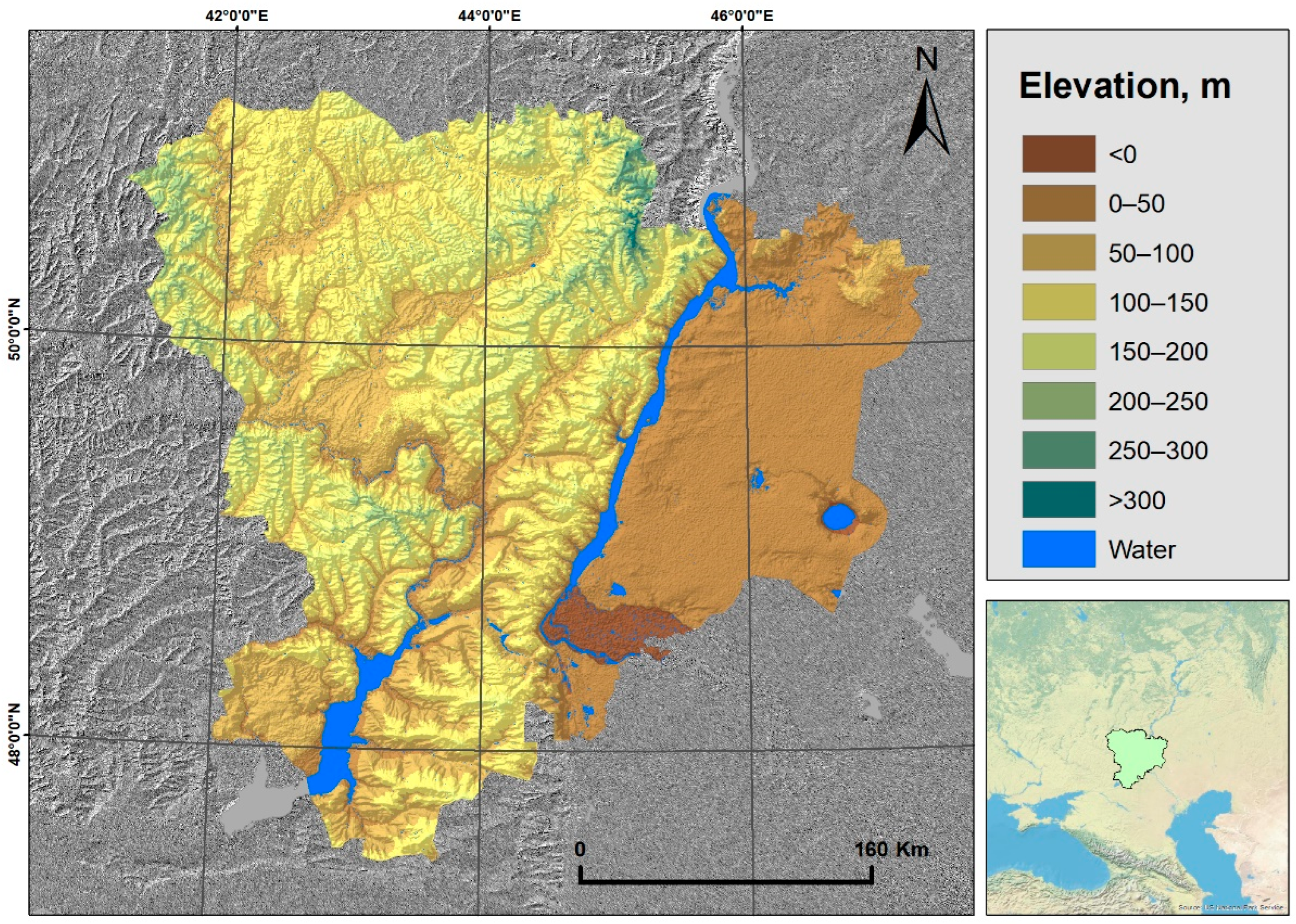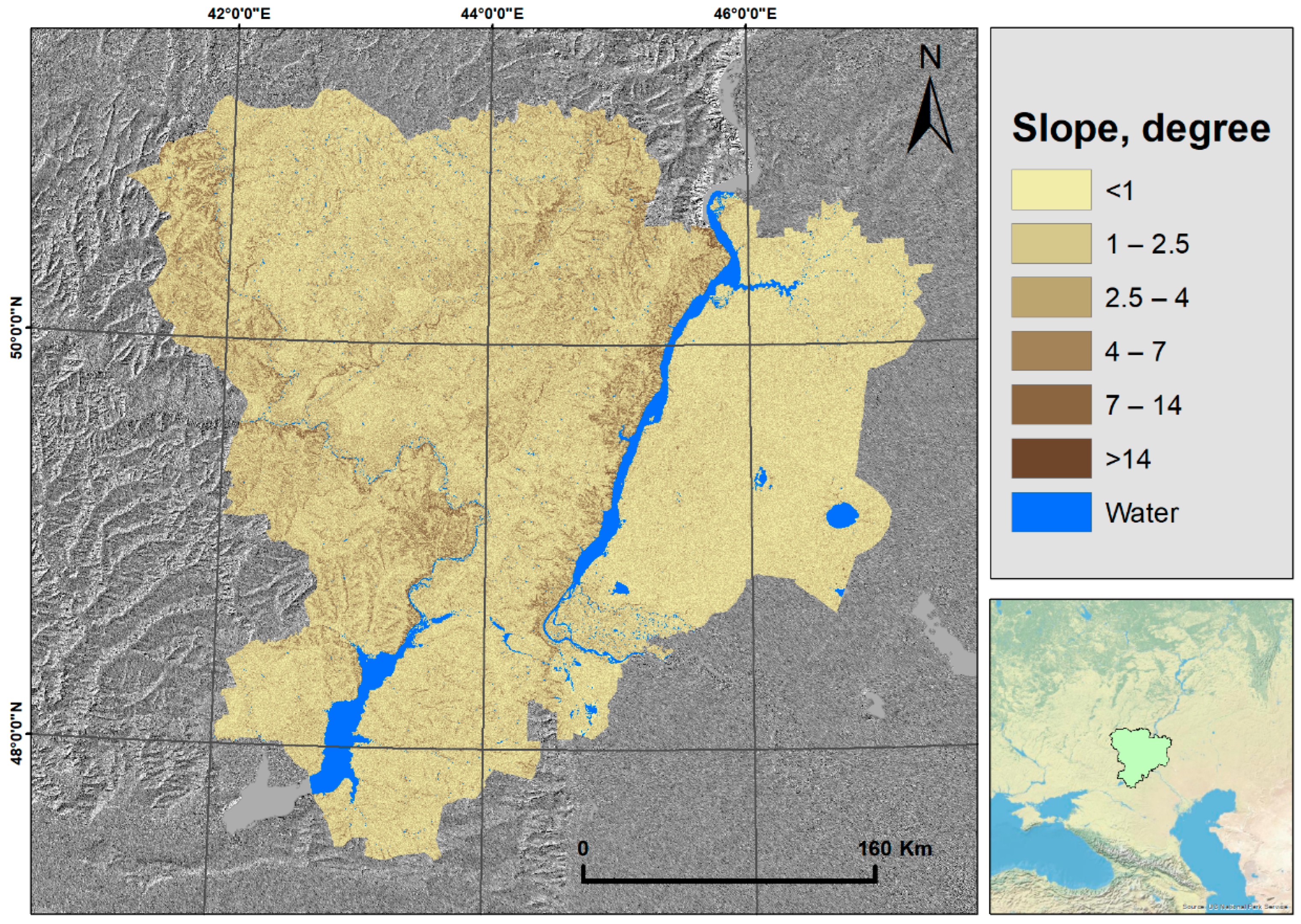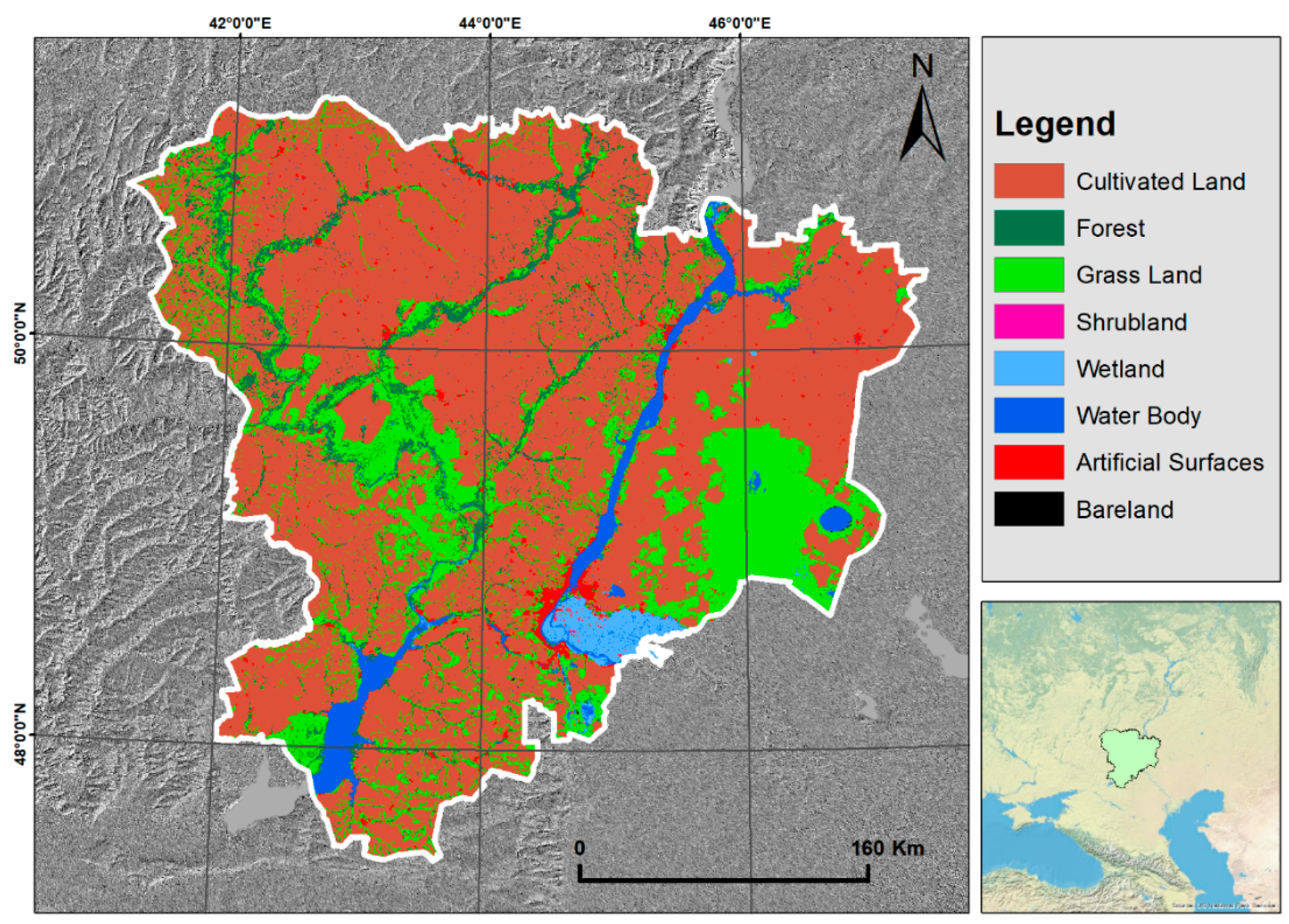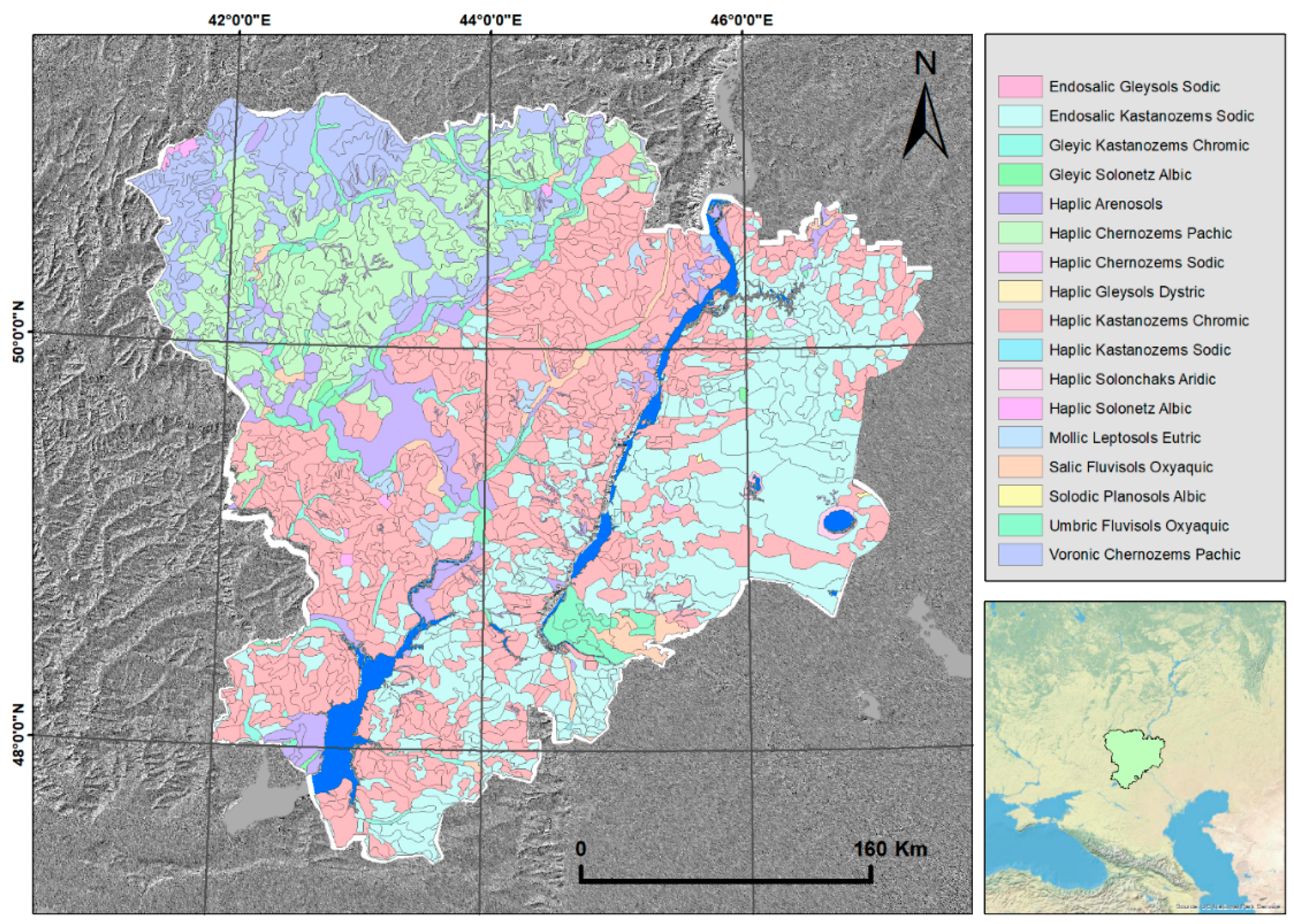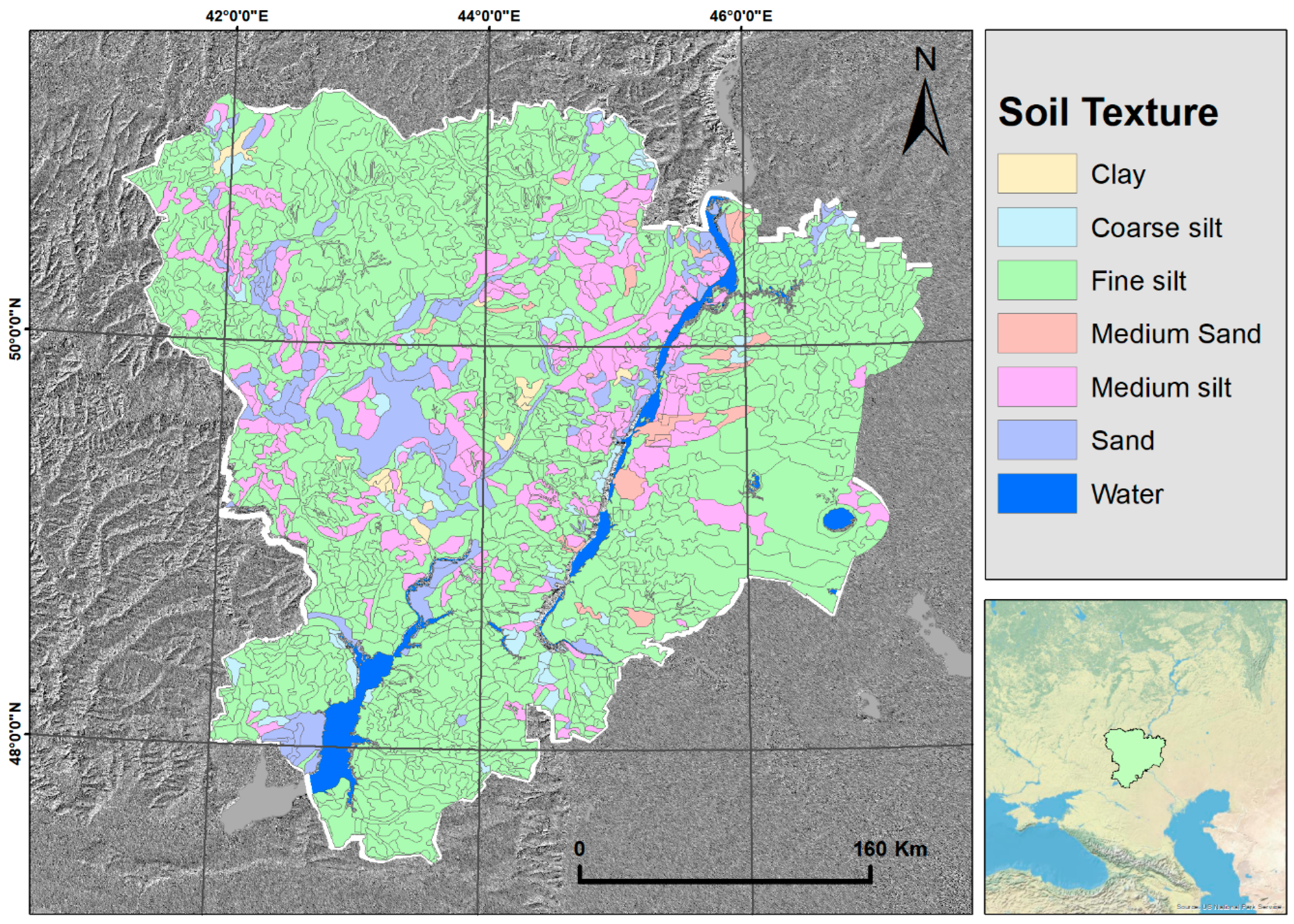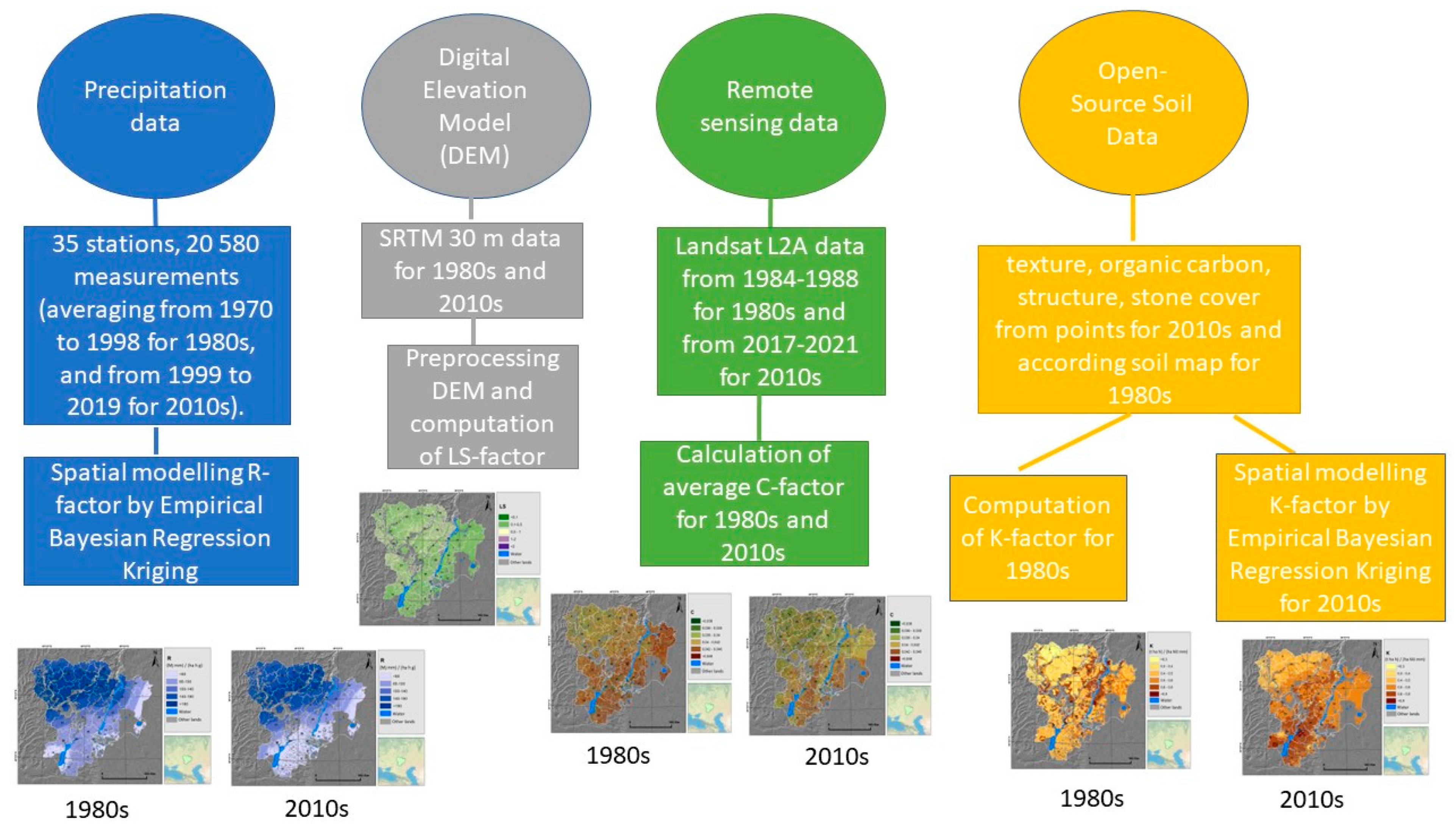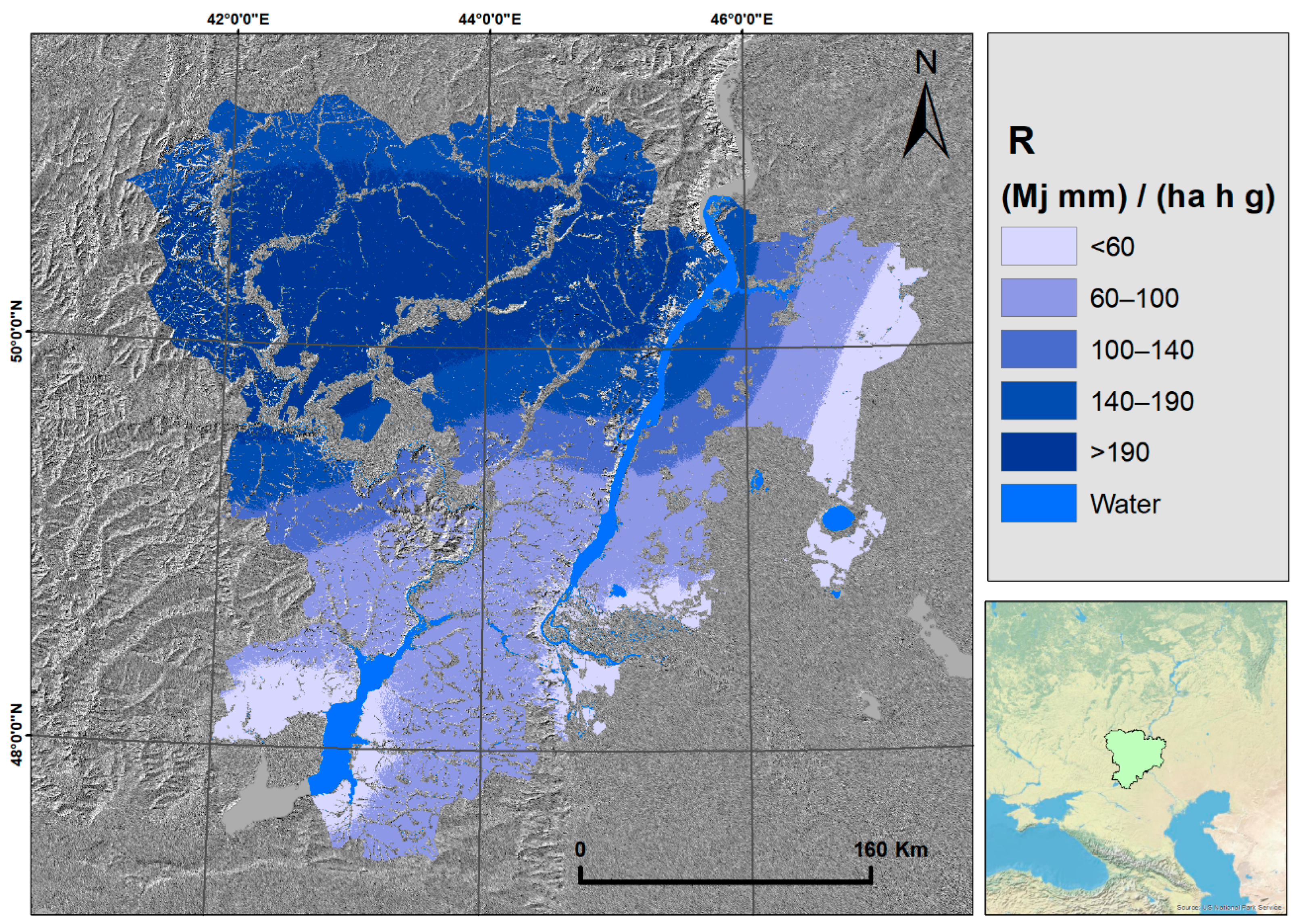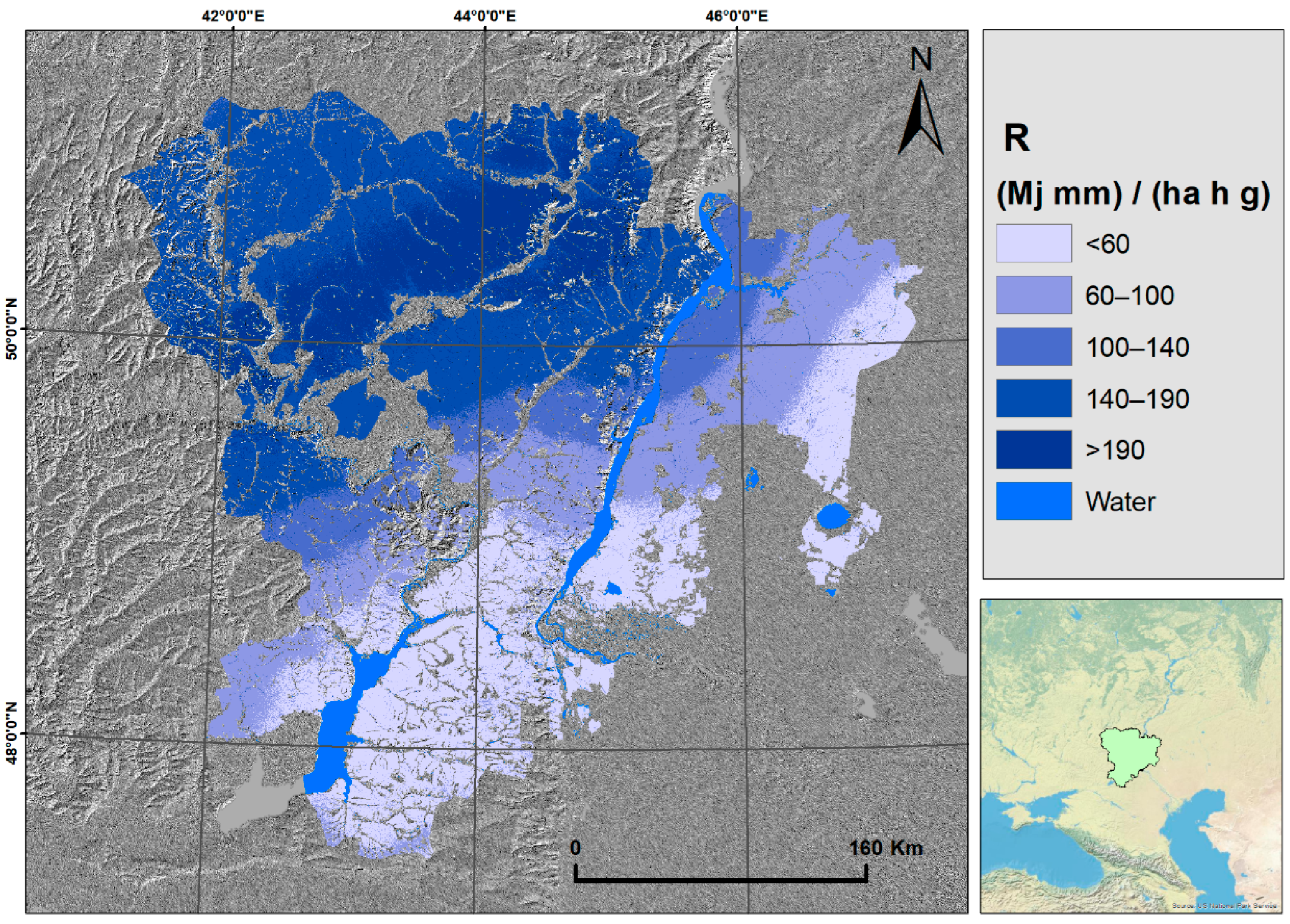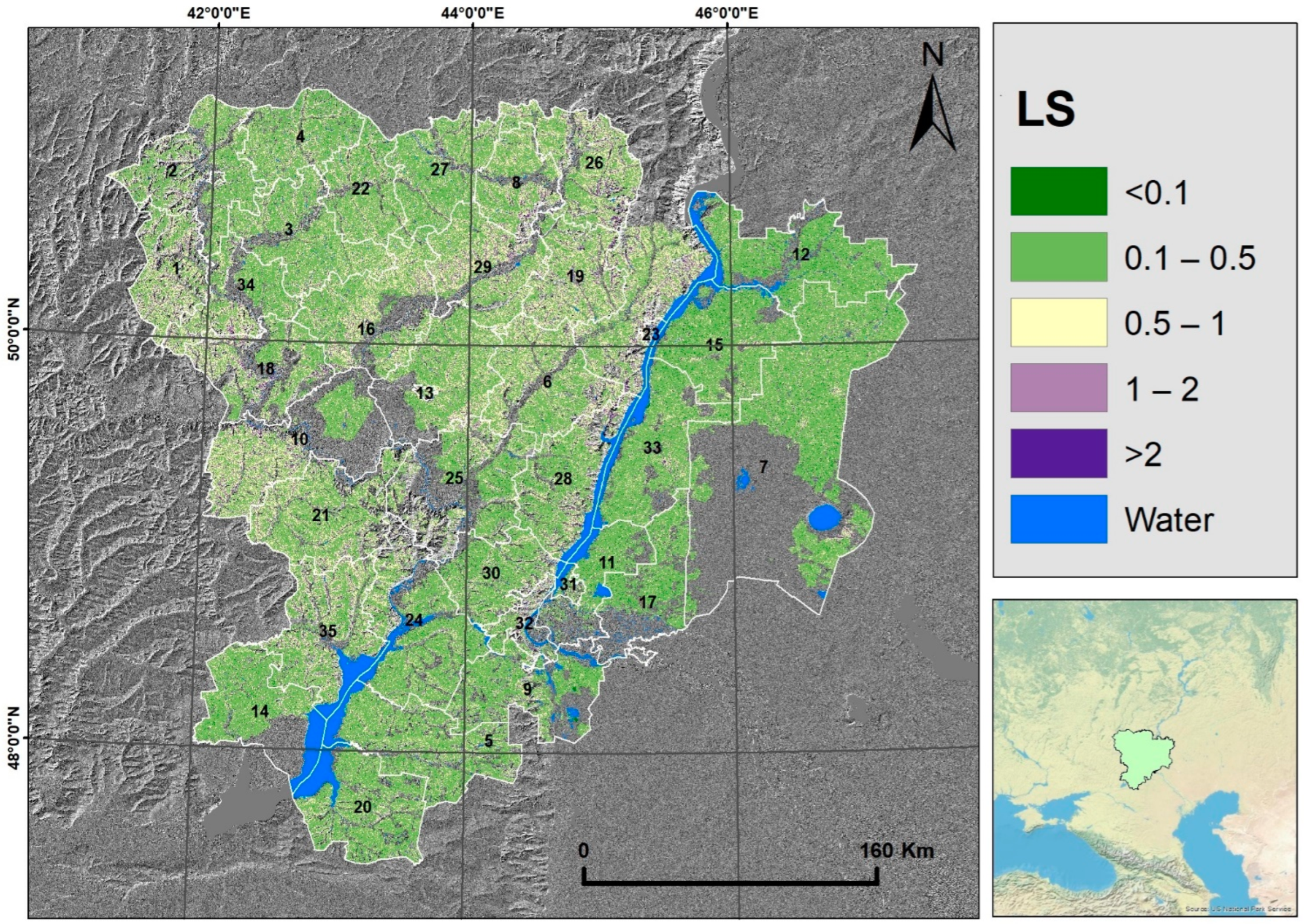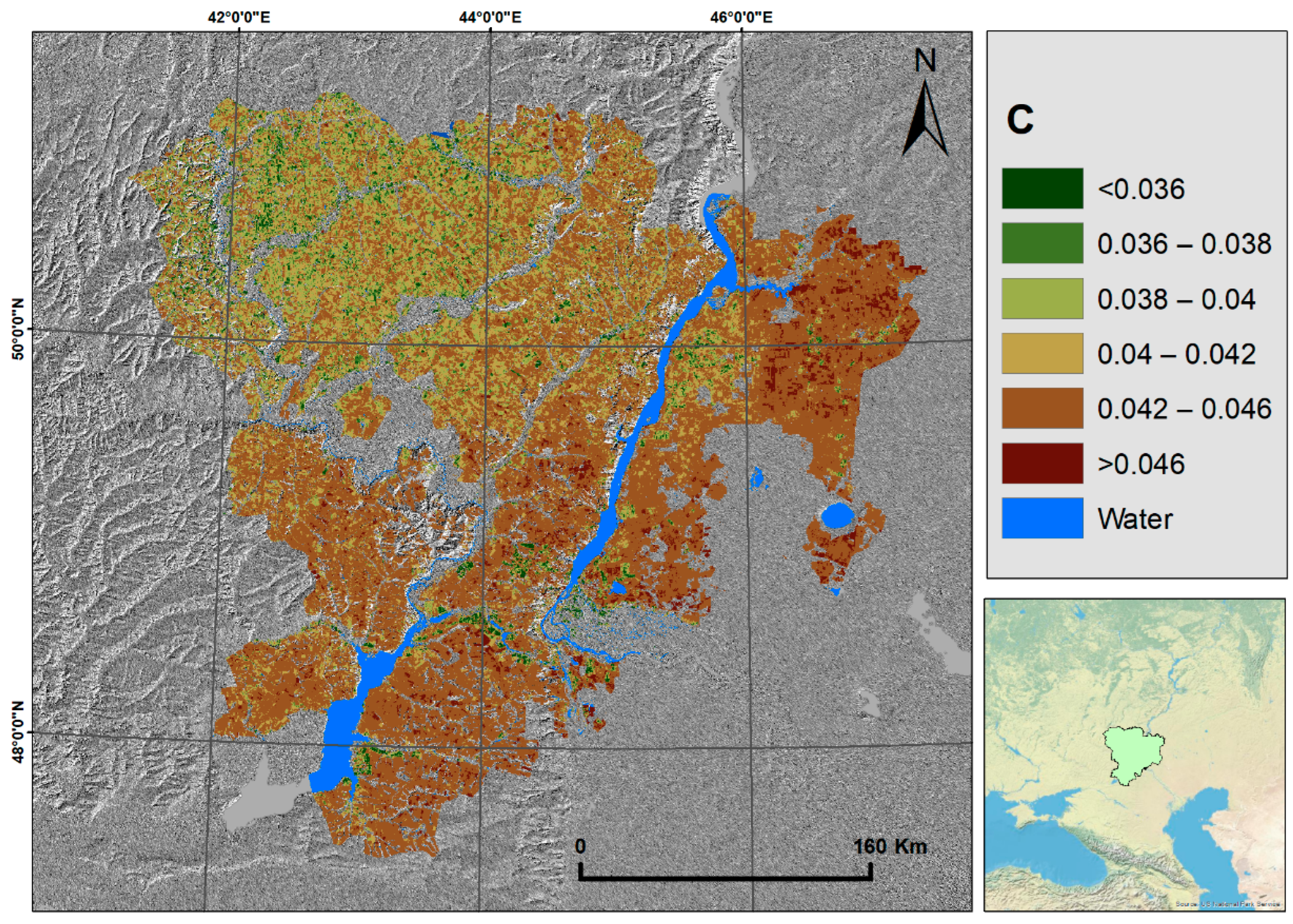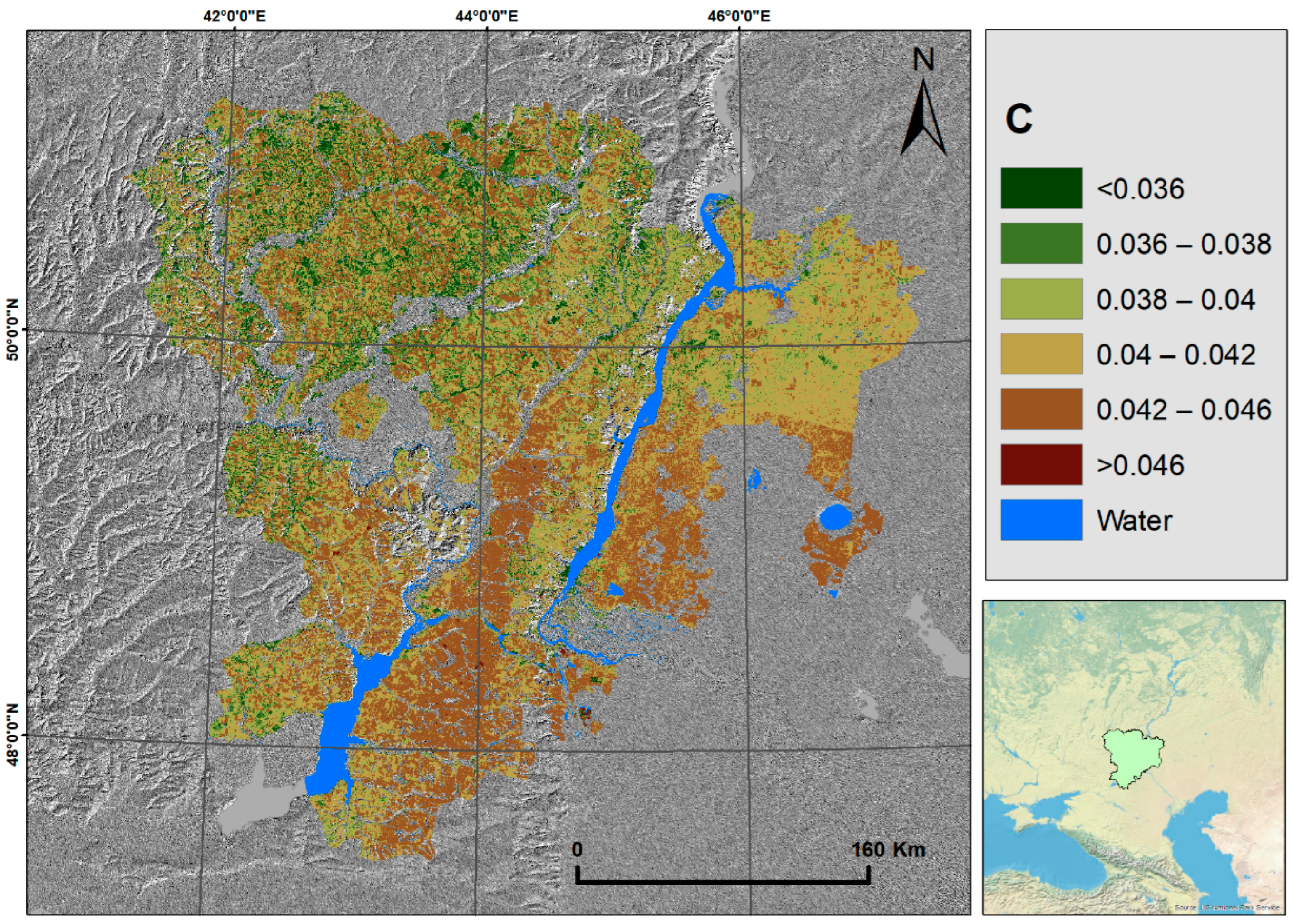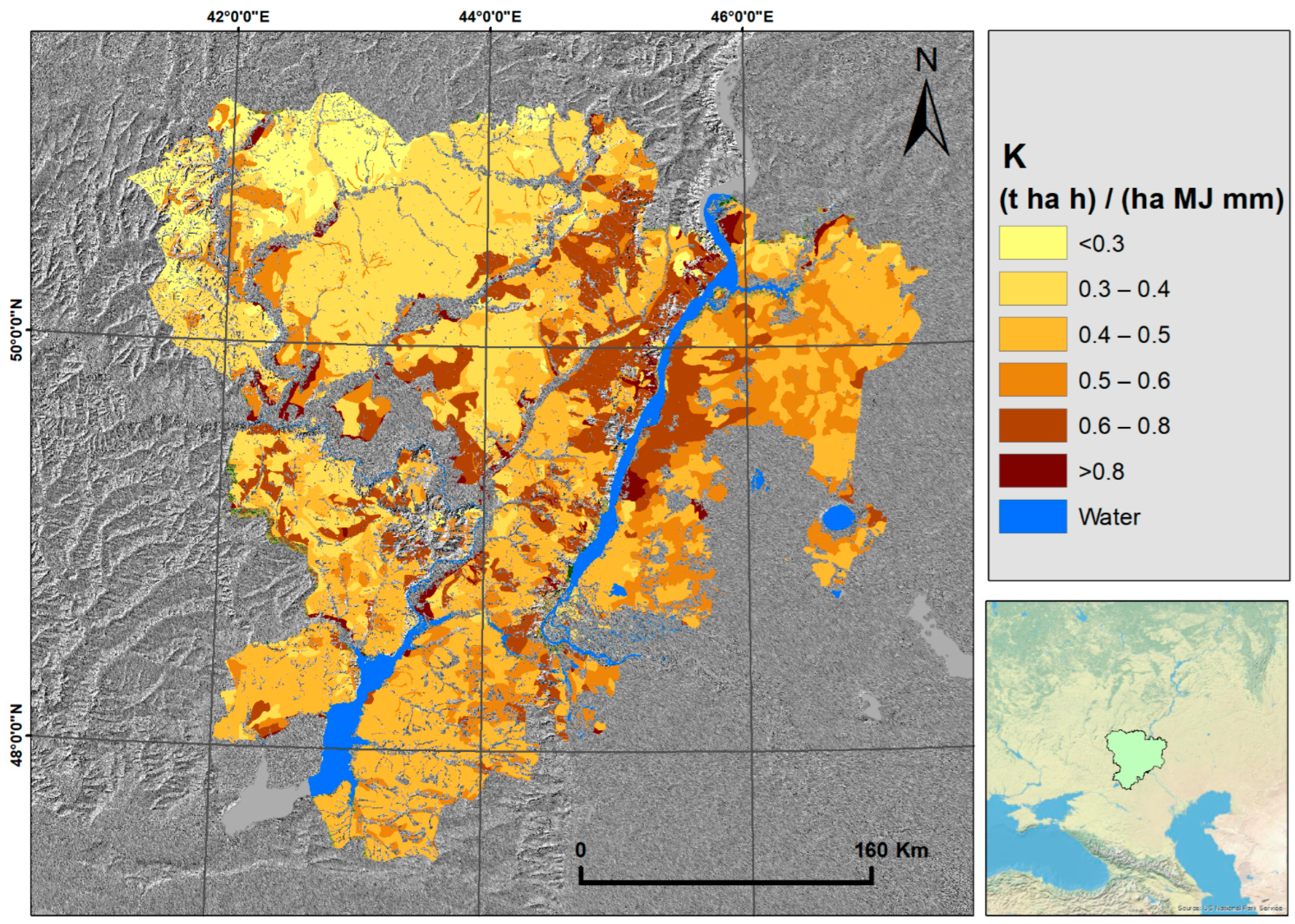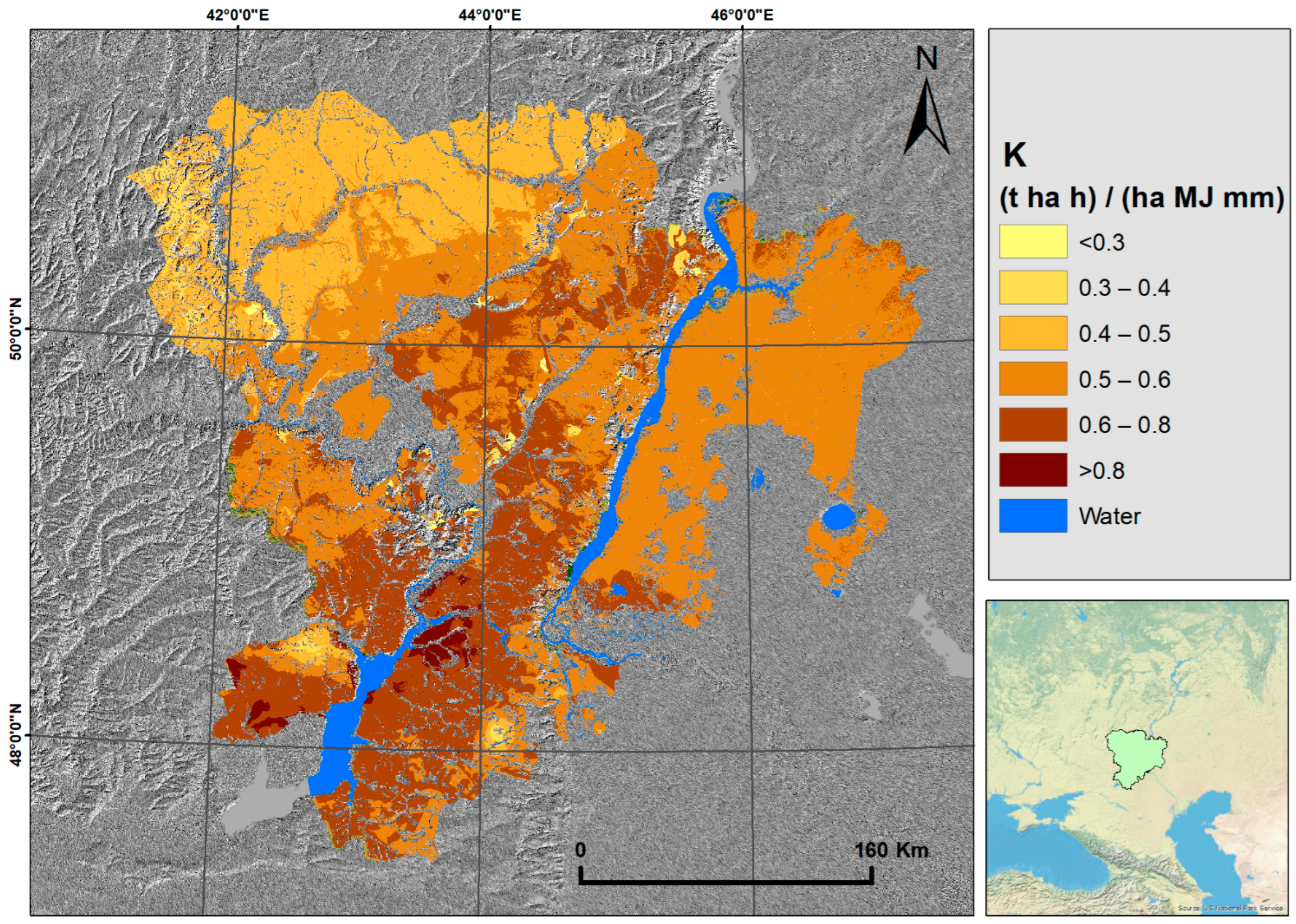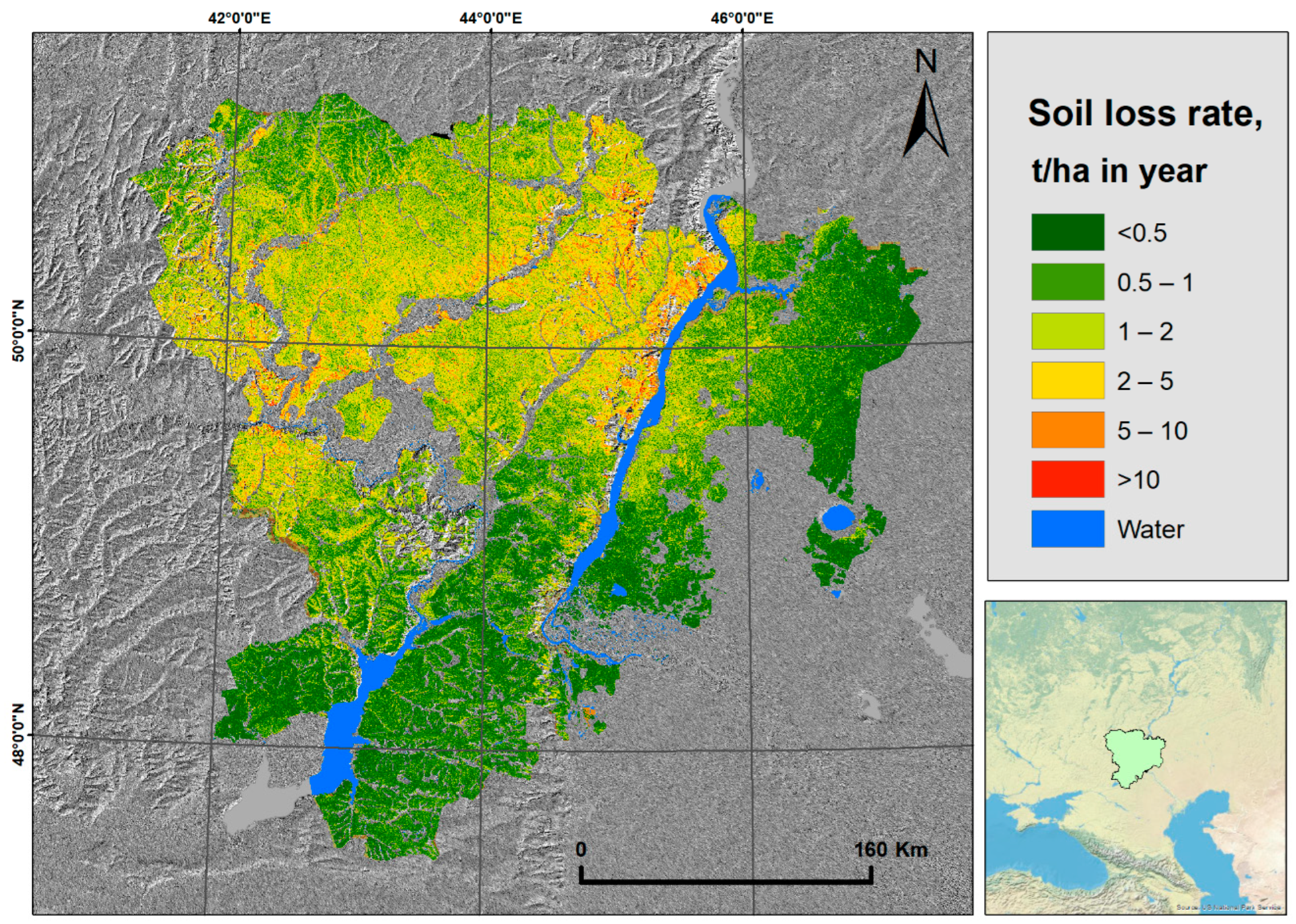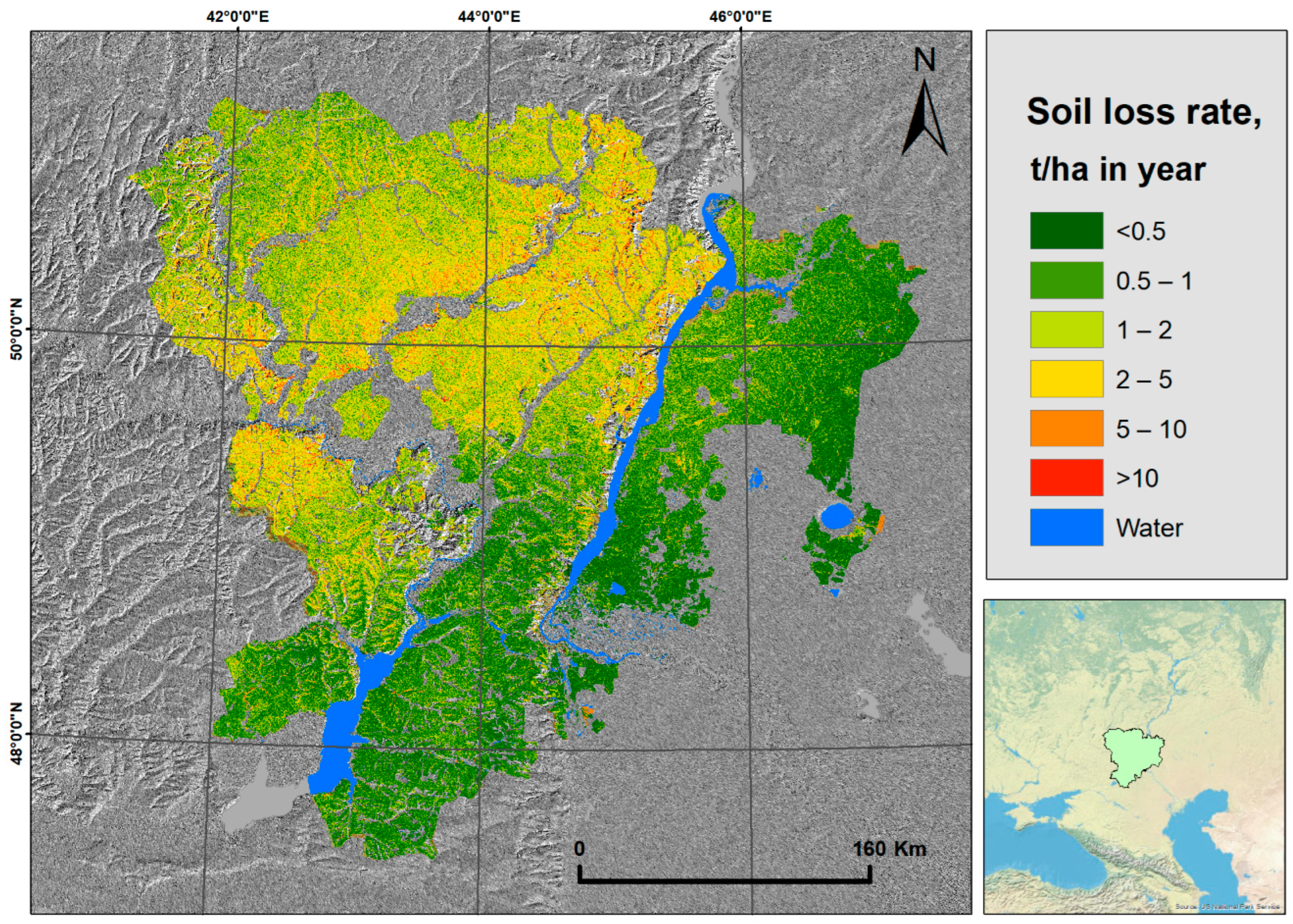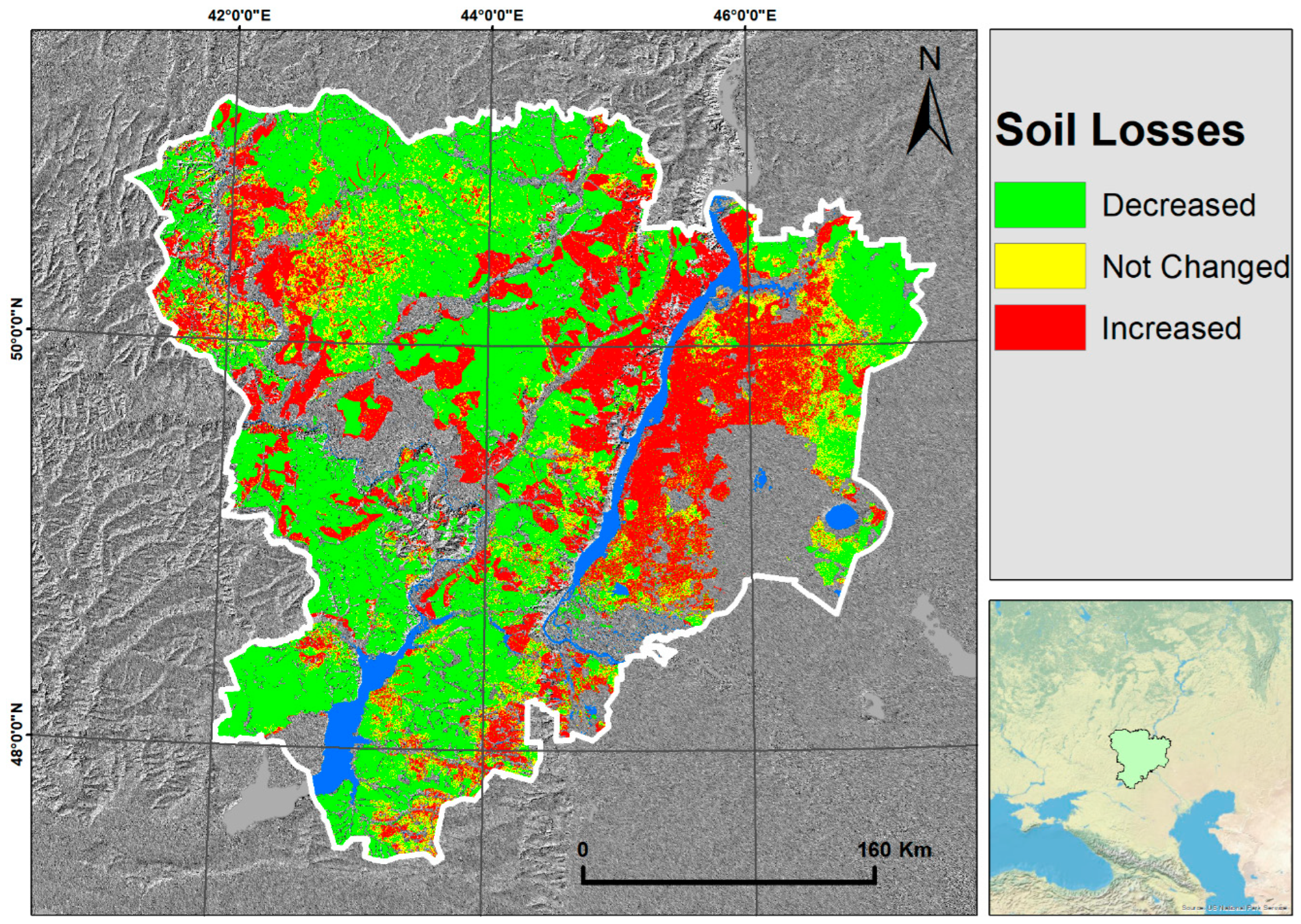3.1. R-Factor
The Figures show the distribution maps of the R-factor on the territory of the Volgograd region in the 1980s (
Figure 7) and 2010s (
Figure 8).
The results of the R-factor for two range computations are presented in
Table 3. The percentage distribution by classes of R-factor values is presented in
Table 4.
The average value of the R-factor in the territory decreased by 9% compared to the level of the 1980s (
Table 5). The share of precipitation with a low erosion potential increased, and with a high one decreased (
Table 6). This fact is evident in the southern part of the region: in the territories where R-factor values were previously recorded in the range of 60–100 Mj·mm/ha·h·g, today values with R-factor <60 Mj·mm/ha·h·g are recorded (
Figure 2 and
Figure 3). In the north of the region, there was also a “displacement” of the erosion zone with an R-factor >190 Mj·mm/ha·h·g to a less dangerous zone with a value of 140–190 Mj·mm/ha·h·g (
Figure 2 and
Figure 3,
Table 6).
However, the standard deviation of the R-factor increased from 64.70 in the 1980s to 74.71 in the 2010s, indicating more significant variability in the R-factor during the more recent period.
The RMSE and CRPS are measures of model accuracy, with lower values indicating a better fit to the data. The lower values in the 1980s suggest that the model performed better in that period than in the 2010s.
3.6. Accuracy of the Results of the Calculation of Soil Erosion
To verify the results obtained, they were compared with the results of another independent research work.
We compared our results with the results from applying the soil erosion model developed under the guidance of G. A. Larionov [
50]. This model was used for different regions of the European part of the Russian Federation in the work of L.F. Litvin and co-authors [
23] and for the assessment of soil loss by soil erosion by water in small river basins in the work of Maltsev and Yermolaev [
20]. In addition, the results were compared with those presented by Golosov with co-authors (Golosov et al., 2018 [
19]). In this work, modified versions of the USLE and SHI erosion models were used for the evaluation mean annual erosion rate for 1986–2012. Only in the work of Litvin and co-authors were results for the regions presented which we could thoroughly compare with our data. The paper by Yermolaev and Maltsev provides data for the current level but by biomes. In the work of Golosov and co-authors, data are given for both the level of the 80s and 2012, but by natural zones. Therefore, we compared the results presented in the work of Maltsev and co-authors with the current value of the soil loss and the results of Golosov and co-authors to the value of the washout of the 1980s to the level of the 2010s. Results are presented in
Table 13.
According to Litvin’s data [
23] soil loss increased by 23.4% compared to the 1980s. We calculated the annual soil loss from the Litvin data for our area. The difference between the total area was because no USSR land use spatial data exist. Therefore, we used actual land use data for the USSR time (Methodology). The discrepancy with Litvin’s results for 1980s level data was 12%, which is extremely small and indicates a good reproducibility and reliability of the results.
The discrepancy with Litvin’s data was only 7.2%, demonstrating the high reproducibility and reliability of the data obtained. The discrepancy for the current level with Golosov and co-author’s data was less than Litvin’s and only 2.5%. But these data were not only produced for the steppe area in the Volgograd region, and represented the entire steppe area in the European plane.
Additionally, we compared our results with the results of local field erosion stations [
51,
52]. The results are presented in
Table 14.
As can be seen from the data obtained, the difference between the field measurements and our results was not critical and ranges from 6 to 15%.
Also, a comparison was made between the Volgograd region’s erosive soil loss map and European Russia’s soil erosion map, created using the same calculation methods [
20]. According to the map, erosive soil losses for the Volgograd region were 0–5 t ha
−1 year
−1. These values are not very different from ours, obtained here (2 t ha
−1 year
−1). Unfortunately, the authors did not published results by regions, only data according to natural zones. The Steppe zone is much broader than the Volgograd region and includes some parts of different areas. However, the results match if compared in the range between several zones presented in the Volgograd region. Semi-desert and steppe areas had mean 2 t ha
−1 year
−1 soil losses, and in our research we had 2 t ha
−1 year
−1.
In addition, we compared our results with the soil erosion map of the European Union [
21]. A close country in landscape and climate conditions is Poland. Poland’s mean soil loss in arable land is 1.61 t ha
−1 year
−1. The difference between our data was 7%.
3.7. Discussion and Perspectives
The average R-factor in the Volgograd region has decreased in recent decades, and there has been more significant variability in the R-factor during the more recent period.
The R-factor depends directly on the amount of precipitation. Therefore, its decrease can be explained by a reduction in precipitation and the development of the aridification process. The results of other independent studies confirm the development of this process; for example, the work of Zolotokrylin and co-authors [
53]. The authors of this work analyzed the dynamics of the Standardized Precipitation Index (SPI) for several southern regions of Russia, including the Volgograd region. It was shown that from 1970 to 2000, a wetter humidification period was observed in the region’s territory. Since 2001, it has been replaced by more arid conditions.
Another paper that has confirmed that fact is the article by Eltsov and co-authors [
54]. In this paper, based on the analysis of climatic and meteorological data for the last 60 years, the authors demonstrated an increase in the aridity of the climate of the Lower Volga region and a shift in the isolines of the aridity index values (according to De Morton—IDM) of the region by about 100 km to the northwest, which also correlates with our data.
The high values of the LS-factor in the Volgograd region were associated with elevated forms of relief and, accordingly, with a higher steepness of the slopes. The main erosion-hazardous areas are the slopes of the right bank of the Volga and Don rivers. A similar pattern was observed with low values of the LS-factor, which were recorded in the region’s territories with low relief forms (the territory of the left banks of the above rivers). The highest values of the LS-factor were observed in the territory of districts, a significant part of the area of which are hills: the southeastern part of the Central Russian Upland (Alekseevsky (No. 34) and Kumylzhensky (No. 18) municipal districts) and the southern part of the Volga Upland (Kamyshinsky (No. 23) and Danilovsky (No. 29) municipal districts) (
Figure 4). The lowest value of the LS-factor was recorded in territories with predominantly low-lying terrain—Sredneakhtubinsky (No. 11), Pallasovsky (No. 7), and Nikolaevsky (No. 15) municipal districts. Approximately 8% of the region’s total agricultural land is dangerous for agriculture (LS-factor > 1).
The values of the LS-factor calculated for the Volgograd Region were in good agreement with the results of similar studies performed for EU countries with predominantly flat territory—Poland, Hungary, Estonia, Netherlands, Latvia, Lithuania, and Denmark [
55]. The average values of the LS-factor for the territories of these countries were 0.52, 0.59, 0.32, 0.19, 0.39, 0.35, and 0.32, respectively.
The area of contours with a high protective potential has increased, while that with a low one has fallen (
Table 10). The indicator of the C-factor in the region’s territory decreased by approximately 6% compared to the level of the 1980s (
Table 9). That means that the protective capacity of vegetation in the region increased by 6%. Most likely, this is due to the overgrowth of agricultural land with natural vegetation, which increased the protective degree of vegetation cover. Natural steppe vegetation has a higher erosion resistance than field crops [
50]. It is worth noting that all this is happening against the background of a decrease in the amount of incoming moisture, both from natural sources (
Section 3.1) and artificial ones. According to the data from Gorokhova and co-authors and Pankova and Novikova [
56,
57] the amount of irrigated land in the Volgograd region has decreased relative to the level of the 1980s. The value of the C-factor in the region increased from north to south and from west to east, which is associated with a decrease in the total biomass of vegetation and an increase in the sparsity of vegetation cover [
50]. Low values of the C-factor corresponded to areas with a high value of the R-factor, and vice versa. This is because territories with a high R-factor value correspond to territories with a large amount of precipitation. Furthermore, moisture is one of the limiting factors in steppe biomes [
57].
Looking at the data, we can see that the range of K-factor values increased from 0.156 to 0.973 in the 1980s to 0.182 to 0.994 in the 2010s, indicating a wider variety of soil erodibility in the latter period. The minimum K-factor value also increased from 0.156 to 0.182, suggesting that even the least erodible soils have become slightly more susceptible to erosion. The maximum K-factor value increased significantly from 0.973 to 0.994, indicating that the most erodible soils have become even more susceptible to erosion. This trend is also reflected in the average K-factor value; the average value of the K-factor increased by 19%, and the erosion resistance of the soil decreased.
The K-factor’s standard deviation (SD) decreased slightly from 0.129 to 0.088, suggesting that the variability of soil erodibility was reduced in the 2010s compared to the 1980s. The RMSE and CRPS, which are measures of the accuracy of a model’s predictions, were only available for the 2010s data, with values of 0.098 and 0.050, respectively. These values indicate that the model used to estimate the K-factor in the 2010s is reasonably accurate in predicting soil erodibility. RMSE and average CRPS for the data of the 1980s were not determined because they were calculated using a direct method based on soil map data.
According to the government data, 52% of agricultural land’s territory is subject to soil organic matter losses [
58]. This is also due to the deterioration of the soil’s basic physical and chemical properties, which affect high erosion resistance, for example a decrease in organic matter content and a change in the soil texture to a lighter one. It is logical to assume that the main factor in reducing erosion resistance is the loss of soil organic matter.
The reasons for soil organic matter losses can be varied. Climate change can change the ratio of humification and mineralization processes in soil erosion. Climate change leads to changes in the ratio erosion level. On the one hand, rainfall erosivity is decreasing. On the other hand, the level of wind erosion should have been increasing. As is known, chernozems soils lost 11–25 t/ha over the last decades in the Volgograd region, or 0.3–0.8% organic matter loss through soil erosion [
59]. Currently, there are no studies to assess the magnitude of wind erosion in the research area, so it is difficult to determine the wind and soil erosion by the water ratio in this area.
The number of soil losses in the territory of the Volgograd region had increased by 16.2% compared to 1980. That demonstrates the trend of an increase in the erosion load on the region’s territory. It is especially noticeable through the change in the structure of the distribution of the amount of soil loss: the area of contours with minimal values of soil erosion by water level (up to 1 t/ha/year) decreased, and the areas of all other shapes increased. The fact that the increase in the amount of soil erosion by water occurred against the background of two compensating phenomena—a decrease in the erosion potential of snowmelt and rainfall runoff and an increase in the protective potential of vegetation, because of changes in land use—is exciting. These processes should lead to a decrease in the territory’s soil erosion by water level. The main factor that led to this is the deterioration of the anti-erosion ability of the soil as a result of losses of SOM. About 53% of the Volgograd region’s agricultural lands are subject to SOM losses [
58]. Such a wide spread of this process has led to an increase in the value of the K-factor by 19% and, as a result, an increase in the amount of soil loss.
Soil erosion by water in the region’s territory decreased from west to east and north to south. That is due to a decrease in the values of the leading actors of erosion processes—the R-factor and LS-factor. In the very northwest of the region, soil erosion by water level is also decreasing. This is due to the widespread chernozem soils, which have high erosion resistance.
